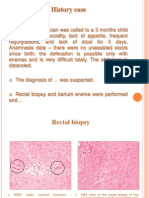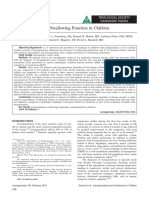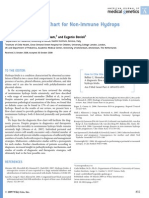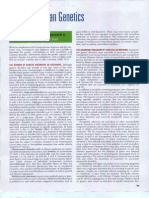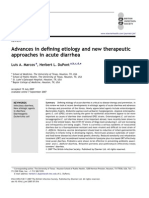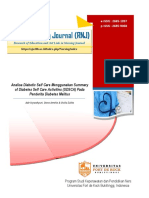ISJ-10575+R
ISJ-10575+R
Uploaded by
Iffah Putri AndiniCopyright:
Available Formats
ISJ-10575+R
ISJ-10575+R
Uploaded by
Iffah Putri AndiniCopyright
Available Formats
Share this document
Did you find this document useful?
Is this content inappropriate?
Copyright:
Available Formats
ISJ-10575+R
ISJ-10575+R
Uploaded by
Iffah Putri AndiniCopyright:
Available Formats
International Surgery Journal
Rodríguez Martínez ADC et al. Int Surg J. 2024 Aug;11(8):1428-1432
http://www.ijsurgery.com pISSN 2349-3305 | eISSN 2349-2902
DOI: https://dx.doi.org/10.18203/2349-2902.isj20242147
Review Article
Hirschsprung's disease: a review
Alicia Del Carmen Rodríguez Martínez1, Sofia Barrientos-Villegas2,
Patricia M. Palacios-Rodríguez3, Erick Fernando Hernández4, Isaim Paris Martínez-Sosa5,
Nalleli Durán-López6, Alan I. Valderrama-Treviño7*
1
Department of Pediatrics, General Hospital of Mexico “Dr. Eduardo Liceaga”, CDMX, Mexico
2
Department of SCIRCES, UCES, Medellín, Colombia
3
Department of Pediatric Surgery, National Institute of Pediatrics, CDMX, Mexico
4
Department of General Surgery, General Hospital of Mexico “Dr. Eduardo Liceaga”, CDMX, Mexico
5
Department of Angiology, Vascular and Endovascular Surgery, Hospital Regional Lic, Adolfo López Mateos, Mexico
6
Department of Pathological Anatomy, Hospital Médica Sur, Mexico City, Mexico
7
Department of Angiology, Vascular and Endovascular Surgery, General Hospital of Mexico “Dr. Eduardo Liceaga”,
CDMX, Mexico
Received: 10 July 2024
Accepted: 25 July 2024
*Correspondence:
Dr. Alan I. Valderrama-Treviño,
E-mail: alan_valderrama@hotmail.com
Copyright: © the author(s), publisher and licensee Medip Academy. This is an open-access article distributed under
the terms of the Creative Commons Attribution Non-Commercial License, which permits unrestricted non-commercial
use, distribution, and reproduction in any medium, provided the original work is properly cited.
ABSTRACT
Hirschsprung disease (HD) is a congenital condition that affects intestinal function due to the absence of ganglion
cells in the myenteric and submucosal plexus of the colon. This absence causes difficulty in intestinal relaxation and,
consequently, normal intestinal evacuation, resulting in severe constipation from birth or early childhood. At the
genetic level, mutations have been identified in genes such as RET, involved in the migration and differentiation of
neural crest cells. The diagnosis is based on rectal biopsies that show the absence of ganglion cells. The main
treatment is surgical, with techniques such as rectosigmoidectomy or pull-through to restore intestinal function.
Despite advances, patients can experience complications such as fecal incontinence. Multidisciplinary management is
crucial to improve the patient's quality of life.
Keywords: HD, Treatment, Management, Ethiopathogenesis, Neural crest cells, Intestinal function
INTRODUCTION The disease usually manifests itself during the first years
of life, usually in these patients it is reflected during the
Hirschsprung's disease (HD) was initially reported by the neonatal period as gastrointestinal symptoms among
Danish pediatrician Harald Hirschsprung in 2 infant which are vomiting, abdominal distention, and even a
patients in 1886. He described it as colonic hypertrophy delay in the passage of meconium, among others. Only
accompanied by symptoms such as severe constipation around 500 total cases with presentation in adulthood
without any mechanical obstructive justification, which is have been reported. Furthermore, a more hidden clinical
why it is attributed the origin of the disease itself is colon presentation has been found in these patients, this is
hypertrophy. Sometime later it was shown that at the explained by the way in which the body compensates for
rectal level and ascending colon the plexus of Auerbach functional obstruction through more proximal
and Meissner lacked ganglion cells. Likewise, alterations hypertrophy.2 HD belongs to a group of diseases called
in innervation were described at the level of the circular dysganglionosis, which includes different anomalies of
muscular and mucosal layer, which leads to greater genetic origin. It is known that the main etiology is due to
difficulty in intestinal relaxation and, therefore, normal a failure that occurs between the fifth and sixth week of
intestinal evacuation.1 gestation in which the ganglion cells must migrate from
International Surgery Journal | August 2024 | Vol 11 | Issue 8 Page 1428
Rodríguez Martínez ADC et al. Int Surg J. 2024 Aug;11(8):1428-1432
the neural crest, and it is even believed that there could be accompanied by this pathology, patients generally present
a defect in the extracellular matrix of the intestinal wall. an altered mucosal barrier in the colon, making them
which would prevent adequate colonization by cells from prone to other diseases.3
the neural crest (Figure 1). Finally, it was shown that
Figure 1 (A and B): Representation of neural crest cell migration in HD.
Embryogenesis of enteric ganglion cells, in the submucosal and myenteric plexuses. Absence of ganglion cells in submucosal plexus,
seen with a 40× objective. Absence of ganglion cells in myenteric plexus, seen with a 40× objective.
Figure 2: Geographic distribution of HD.
Collection of some epidemiological data on prevalence of HD.
The most common clinical presentation of HD is early- Management in recent years has evolved significantly.
onset constipation, predominantly in newborns, Initially Swenson focused on performing a transmural
especially those with full-term gestation. It also presents dissection, in which he ultimately left patients with an
as intestinal obstruction in newborns and bloating. To ostomy. Over the years, the Georgeson technique
make an initial approach, it is important to perform an appeared, which combined laparoscopic methods to
anorectal manometry, colon by enema and finally perform a primary trans-anal descent. However, it has
confirmation is performed through a rectal biopsy.
International Surgery Journal | August 2024 | Vol 11 | Issue 8 Page 1429
Rodríguez Martínez ADC et al. Int Surg J. 2024 Aug;11(8):1428-1432
been observed that at least 50% of these post-surgical patients, unlike women where a lower common number
patients are left with defecatory incontinence.4 of T allele subtypes was found. although with a higher
risk of recurrence at the family level.9-11
Fecal incontinence is just one of the few complications
resulting from HD. Management by an interdisciplinary Additionally, Guevara et al carried out a study on the
team is of great importance to provide an adequate different genetic polymorphisms of the RET proto-
quality of life in adulthood for these patients, so follow- oncogene that have been associated with HD in children
up by surgery, pediatrics and psychology should not be from Ecuador. Among the results, the A45A
missing in the follow-up of these patients.5 polymorphism stands out, which was significantly
associated with HD; in addition, the A432A
EPIDEMIOLOGY polymorphism demonstrated a protective role against the
disease. Therefore, it demonstrates the importance of
The presentation of HD has been reported in polymorphisms in the RET proto-oncogene and its
approximately 1 in 5000 live births. More frequently in relationship with HD. Those patients who were shown to
patients born at term and of white race with a greater have the c135a variation in RET had a strong association
predominance of male patients with a ratio of 3-5:1.3 with suffering from HD.6
Around 95% of HD patients are diagnosed before the first
year of life and in the neonatal stage. Different Finally, it is known that more than 80% of patients with
polymorphisms have been reported within the RET gene, HD present a heritability factor, associated with different
which has been shown to be involved in the development genetic variations that could also be related to other
of HD, the c135 polymorphism has been reported in genetic alterations such as Down syndrome in 7.32% of
different populations such as Spanish, German, Italian, individuals and in a 50% was found to be associated with
Chinese, Polish and American, putting 11 times more at congenital heart defects. Other congenital alterations that
risk of suffering from HD in these populations. This were found associated with HD are Waardenburg
possibly as a consequence of evolutionary migration from syndrome, congenital deafness, malrotation of the gastric
Africa to Asia and Europe.6 Unlike developed countries, diverticulum and intestinal atresia.12
only 20-40% of patients present as neonates and the
average age of presentation is 24 months.7 A study carried CLINICAL MANIFESTATIONS
out in Canada by Nasr et al. sought to determine the
incidence of HD in Ontario, Canada, they found an HD presents as an absence of involuntary relaxation of
incidence of HD in Canada, similar to that reported in the internal anal sphincter, which is represented
Scotland, Germany, England, Denmark, United States, symptomatically in 70% of patients during the first days
Japan, Oman which varied approximately between 1 in of life, such as constipation, delay in the elimination of
5,000 live births (Figure 2).8 meconium. In approximately 10% of patients, the disease
occurs between 3 and 14 years of age (Figure 3).
EPIGENETICS AND MOLECULAR BASES However, the age of presentation and its symptoms
depend on the classification of disease, which will vary
Genetic alterations related to the appearance of HD have depending on the affected intestinal segments (Table 1).13
been found. Among which chromosomes 2, 10 and 13
stand out with the genes RET, GDNF, NTN, ENDR-B,
EDN3, ECE1. One of the most studied genes is the RET
gene, a gene with a receptor tyrosine kinase expressed in
cells derived from the neural crest, located on
chromosome 10q11.2, which has been found present in
up to 50% of familial cases, in addition, mutations of this
gene have been associated with Multiple Endocrine
Neoplasias (MEN) 2A, MEN 2B and HD. In a study Figure 3: Anatomical representation of HD according
carried out by Emission et al in more than 690 Europeans to its types of presentation.
and 192 patients of Chinese descent, in which it was In bright red are the affected colony areas according to each
demonstrated that susceptibility in the RET amplifier is type of presentation of HD; A: EH in short segment. B: EH in
generated as a result of a failure in SOX10, which is long segment. C: Total colonic HE.
responsible for activating RET transcription. All of this is
probably the product of a single mutation of a T allele, Patients with chronic constipation, nutritional and growth
which is significantly elevated in HD. Historically, it is disorders are commonly observed. Upon rectal
believed that as a result of population migration from examination, these patients present hypertonia of the anal
Africa towards Asia and Europe, there are enough cases sphincter, and the rectal ampulla is empty. It is frequently
known to explain the difference and susceptibility of the found as a case of enterocolitis that has symptoms of
disease between these populations. Furthermore, a greater fever, abdominal distension, diarrhea, this because of the
number of cases was found in those T alleles with a dilation of the loops which generates an increase in
greater common number of subtypes, in this case male intraluminal pressure which ends up reducing blood flow,
International Surgery Journal | August 2024 | Vol 11 | Issue 8 Page 1430
Rodríguez Martínez ADC et al. Int Surg J. 2024 Aug;11(8):1428-1432
creating an environment for bacterial stagnation and a subsequent anastomosis. It is important to perform
growth. Enterocolitis represents 30% of mortality in decompression of the intestinal loops once the diagnosis
patients with HD, due to the high risk of intestinal is made in order to be able to perform the surgical
perforation and sepsis.3 intervention as soon as possible and to avoid the
appearance of complications of the disease such as
Table 1: Types and characteristics in HD. necrotizing enterocloitis. Decompression is achieved
through Rectal irrigations at least 3 times a day, if they
Segment are not successful, an ostomy will be used. According to
affected by Characteristic recommendations, the safest empirical form of ostomy
HD for these patients is the ileostomy. Other scenarios have
Short Absence of ganglion cells at the rectal been described in which the use of the ostomy is resorted
segment level and even the lower part of the to, such as those patients where HD affects the entire
disease sigmoid colon. colon or if they have complications such as necrotizing
Absence of ganglion cells at the rectal enterocolitis, megacolon or suffer from intestinal
level and in greater quantities at the perforation.14,15 Depending on the age of presentation, it
Long
colonic level compared to short will be decided to perform the surgery in one or two
segment
segment disease, but at least nerve stages. Generally, older patients undergo a one-time
disease
cells are found in one segment of the surgical intervention and newborns and younger infants’
colon. resort to first performing a procedure to leave a discharge
Absence of ganglion cells in the ostomy and, in the same intervention, taking biopsies
Total colonic rectum and entire colon, but they are after waiting about 6 months. perform definitive surgical
disease present in the tip of the small correction. Currently, 3 surgical methods have been
intestine. described, among which rectosigmoidectomy, trans-anal
recto-rectal pull-through, and endorectal pull-through
DIAGNOSIS stand out. To these surgical processes are added the use
of new creations such as the use of mechanical sutures or
The gold standard for the diagnosis of HD is the rectal intraluminal intestinal staplers, since they facilitate the
biopsy, with a sensitivity of 93% and a specificity of possibility of performing a faster, safer and more
98%. This biopsy should ideally be taken at a distance of successful surgical approach, through the reaction of
3 cm from the dentate line and in which it will be good anastomoses. and safe. In those patients who
possible to observe Through hematoxylin-eosin staining present necrotizing enterocolitis or significant loop
and histopathological studies, the absence of ganglion dilation, ostomies are recommended, generating
cells, the presence of hypertrophic nerve fibers, an decompression while waiting for intestinal recovery.3,16 A
increase in Acetylcholinesterase activity and the absence study carried out by Oyania et al sought to determine the
of calretinin-positive fibers in the lamina propria safety of closing an ostomy in the same surgical process
confirmed the diagnosis.2 However, to reach this as pull-through corrective surgery and found that it was a
diagnosis through biopsy, generally when other possible safe intervention that avoided performing management in
pathologies are suspected, other diagnostic tests are 3 surgical moments, a process which generates greater
performed initially, among these is anorectal manometry morbidity and a decrease in the quality of life. However,
which has a sensitivity of 91% and a specificity of 94%. they say more studies are needed to understand the
Anorectal manometry, although it could guide towards impact on patients.17 Despite the advanced methods
the diagnosis of HD, is considered more as a screening currently used for the surgical approach to HD, some
test, which is why it does not confirm the diagnosis. It is post-surgical complications have been reported in 8 to
a non-invasive test through the introduction of a balloon 10%, such as mainly necrotizing enterocolitis, followed
catheter that will distend upon entry, this will evaluate the by perianal leakage of fecal matter, stenosis. Anal or
function of the internal anal sphincter. If an absence of rectal, surgical site infection or abscess formation,
the inhibitory anal reflex is found, it would guide a urinary incontinence and could even continue with
diagnosis of HD. The use of colon enema is also useful in persistent constipation. Other possible complications are
guiding the diagnosis of HD. It provides, through images, the formation of adhesions with subsequent involvement
the morphological characterization of the presentation of intestinal obstruction. The management of these
and generally demarcates what is known as the transition complications depends on their level and severity, which
zone of the disease; However, this transition zone does will vary from antibiotic management, drainage or return
not always correspond to the histopathologically studied to the operating room for surgical correction.18,19
transition zone, especially in those patients with a clinical
presentation of HD in the sigmoid rectum.5 CONCLUSION
TREATMENT Hirschsprung disease is a congenital condition that
affects intestinal function due to the absence of ganglion
The management of HD is mainly surgical in nature cells in the myenteric and submucosal plexus of the
which seeks to extract the affected colonic segment with colon. This absence leads to abnormal contraction of the
International Surgery Journal | August 2024 | Vol 11 | Issue 8 Page 1431
Rodríguez Martínez ADC et al. Int Surg J. 2024 Aug;11(8):1428-1432
colon, resulting in severe constipation from birth or early teaching hospital in Northwestern Tanzania. BMC
childhood. At the genetic level, mutations have been Res Notes. 2014;7:410.
identified in several genes, including RET and others 8. Nasr A, Sullivan KJ, Chan EW, Wong CA,
related to the migration and differentiation of neural crest Benchimol EI. Validation of algorithms to determine
cells. The diagnosis is made by rectal biopsy, which incidence of Hirschsprung disease in Ontario,
reveals the absence of ganglion cells. The main treatment Canada: a population-based study using health
is surgical, with techniques such as rectosigmoidectomy administrative data. Clin Epidemiol. 2017;9:579-90.
or various types of pull-through to remove the affected 9. Lorente-Ros M, Andrés AM, Sánchez-Galán A,
portion of the colon and restore adequate intestinal Amiñoso C, García S, Lapunzina P, et al. New
function. Despite advances in surgical management, mutations associated with Hirschsprung disease. An
patients may experience complications such as fecal Pediatr (Engl Ed). 2020;93(4):222-7.
incontinence. Multidisciplinary management is crucial to 10. Emison ES, Garcia-Barcelo M, Grice EA, Lantieri F,
optimize the quality of life of patients, addressing Amiel J, Burzynski G, et al. Differential
medical, surgical and psychological aspects. Although the contributions of rare and common, coding and
disease is more common in white, full-term newborns, noncoding Ret mutations to multifactorial
cases have been reported in adults, highlighting the Hirschsprung disease liability. Am J Hum Genet.
importance of continued surveillance and long-term 2010;87(1):60-74.
follow-up. Hirschsprung disease represents a significant 11. Edery P, Lyonnet S, Mulligan LM, Pelet A, Dow E,
clinical challenge that requires a comprehensive and Abel L, et al. Mutations of the RET proto-oncogene
personalized approach for each patient, with the goal of in Hirschsprung's disease. Nature.
minimizing complications and improving long-term 1994;367(6461):378-80.
outcomes. 12. Ali A, Haider F, Alhindi S. The Prevalence and
Clinical Profile of Hirschsprung’s Disease at a
Funding: No funding sources Tertiary Hospital in Bahrain. Cureus.
Conflict of interest: None declared 2021;13(1):e12480
Ethical approval: Not required 13. Uylas U, Gunes O, Kayaalp C. Hirschsprung's
Disease Complicated by Sigmoid Volvulus: A
REFERENCES Systematic Review. Balkan Med J. 2021;38(1):1-6.
14. Neuvonen MI, Kyrklund K, Rintala RJ, Pakarinen
1. Amiel J, Lyonnet S. Hirschsprung disease, associated MP. Bowel function and quality of life after
syndromes, and genetics: a review. J Med Genet. transanal endorectal pull-through for Hirschsprung
2001;38(11):729-39. disease: controlled outcomes up to adulthood. Ann
2. Rojas-Gutiérrez CD, Haro-Cruz JS, Cabrera-Eraso Surg. 2017;265(3):622-9.
DF, Torres-García VM, Salas-Álvarez JC, Valencia- 15. Montalva L, Cheng LS, Kapur R, Langer JC, Berrebi
Jiménez JO, et al. Reporte de caso: vólvulo de D, Kyrklund K, et al. Hirschsprung disease. Nat Rev
sigmoides en un adulto joven, una manifestación de Dis Primers. 2023;9(1):54.
enfermedad de Hirschsprung. Cir Cir. 16. Crehuet Gramatyka C, Gutiérrez San Román R,
2022;90(6):842-7. Fonseca Martín J, Barrios Fontoba A, Mínguez
3. Weber Estrada N. Enfermedad de Hirschsprung. Rev Gómez P, Ortolá Fortes I, et al. Evaluación a largo
Med Costa Rica Centroamerica LXI. plazo de la cirugía transanal con sutura automática en
2012;(602):251-6. la enfermedad de Hirschsprung. Cir Pediatr.
4. Rocca AM, Nastri M, Takeda S, Neder D, Mortarini 2019;32:195-200.
A, Paz E, Lavorgna S, Bazo M, Dibenedetto V. 17. Oyania F, Kotagal M, Wesonga AS, Nimanya SA,
Recommendations for the diagnosis and treatment of Situma M. Pull-Through for Hirschsprung 's Disease:
persistent postsurgical symptoms in Hirschsprung Insights for Limited-Resource Settings from
disease. Arch Argent Pediatr. 2020;118(5):350-7. Mbarara. J Surg Res. 2024;293:217-22.
5. KA Santos-Jasso. Enfermedad de Hirschsprung. Acta 18. Defilippi GC, Salvador UV, Larach KA. Diagnóstico
Pediatr México. 2017;38(1):72-8. y tratamiento de la constipación crónica. Rev Méd
6. Guevara MJ, López-Cortés A, Jaramillo- Clíni Las Condes. 2013;24(2):277-86.
Koupermann G, Cabrera A, Rodríguez R, Franco D, 19. Levitt MA, Dickie B, Peña A. Evaluation and
et al. Polimorfismos genéticos del proto-oncogén treatment of the patient with Hirschsprung disease
RET asociados con la enfermedad de Hirschsprung who is not doing well after a pull-through procedure.
en niños de la población ecuatoriana. Rev Med Seminars Pediatr Surg. 2010;19(2):146-53.
Vozandes. 2012;23:97-104.
7. Mabula JB, Kayange NM, Manyama M, Chandika Cite this article as: Rodríguez Martínez ADC,
AB, Rambau PF, Chalya PL. Hirschsprung 's disease Barrientos-Villegas S, Palacios-Rodríguez PM,
in children: a five year experience at a university Hernández EF, Martínez-Sosa IP, Durán-López N, et
al. Hirschsprung's disease: a review. Int Surg J
2024;11:1428-32.
International Surgery Journal | August 2024 | Vol 11 | Issue 8 Page 1432
You might also like
- Background: Hirschsprung Disease. Contrast Enema Demonstrating Transition Zone in The Rectosigmoid RegionNo ratings yetBackground: Hirschsprung Disease. Contrast Enema Demonstrating Transition Zone in The Rectosigmoid Region9 pages
- Non-Immune Fetal Hydrops: Are We Doing The Appropriate Tests Each Time?No ratings yetNon-Immune Fetal Hydrops: Are We Doing The Appropriate Tests Each Time?3 pages
- Hirschsprung's Disease: (Congenital Aganglionic Megacolon)No ratings yetHirschsprung's Disease: (Congenital Aganglionic Megacolon)16 pages
- Infantile Hypertrophic Pyloric Stenosis: A Single Institution's ExperienceNo ratings yetInfantile Hypertrophic Pyloric Stenosis: A Single Institution's Experience3 pages
- January - Hirschsprung's Disease in Africa 21 CenturyNo ratings yetJanuary - Hirschsprung's Disease in Africa 21 Century27 pages
- Page From Thompson Thompson Genetics in Medicine 8No ratings yetPage From Thompson Thompson Genetics in Medicine 82 pages
- Early Human Development: Charlotte Wetherill, Jonathan SutcliffeNo ratings yetEarly Human Development: Charlotte Wetherill, Jonathan Sutcliffe6 pages
- Alientacion y Problemas Gastrointestinales SDNo ratings yetAlientacion y Problemas Gastrointestinales SD8 pages
- 2017-Is There A Relation Between Occult Celiac Disease and Functional DyspepsiaNo ratings yet2017-Is There A Relation Between Occult Celiac Disease and Functional Dyspepsia7 pages
- Laryngomalacia and Swallowing Function in ChildrenNo ratings yetLaryngomalacia and Swallowing Function in Children7 pages
- A Diagnostic Flow Chart For Non-Immune HydropsNo ratings yetA Diagnostic Flow Chart For Non-Immune Hydrops2 pages
- Emergency Complications of Hirschsprung DiseaseNo ratings yetEmergency Complications of Hirschsprung Disease17 pages
- Cute Appendicitis in Children: Emergency Department Diagnosis and ManagementNo ratings yetCute Appendicitis in Children: Emergency Department Diagnosis and Management13 pages
- Awareness of Patients With Symptomatic Gallstones Regarding Their Own DiseaseNo ratings yetAwareness of Patients With Symptomatic Gallstones Regarding Their Own Disease3 pages
- AGA DDSEP 10 Chapter 16 QA 1654540130272No ratings yetAGA DDSEP 10 Chapter 16 QA 165454013027230 pages
- Neonatal Bowel Obstruction: David Juang,, Charles L. SnyderNo ratings yetNeonatal Bowel Obstruction: David Juang,, Charles L. Snyder27 pages
- Etiology and Outcome of Hydrops Fetalis: SciencedirectNo ratings yetEtiology and Outcome of Hydrops Fetalis: Sciencedirect1 page
- Post Cholecystectomy Syndrome in Pediatric PatientNo ratings yetPost Cholecystectomy Syndrome in Pediatric Patient4 pages
- Intraoperative Finding in Total Colonic AganglionosisNo ratings yetIntraoperative Finding in Total Colonic Aganglionosis12 pages
- Chilaiditi Syndrom in Child Diagnostic Trap (Case Report)No ratings yetChilaiditi Syndrom in Child Diagnostic Trap (Case Report)6 pages
- Congenital Diaphragmatic Hernia:: Updates and OutcomesNo ratings yetCongenital Diaphragmatic Hernia:: Updates and Outcomes16 pages
- Adult Idiopathic Hypertrophic Pyloric Stenosis A Common Presentation With An Uncommon DiagnosisNo ratings yetAdult Idiopathic Hypertrophic Pyloric Stenosis A Common Presentation With An Uncommon Diagnosis5 pages
- Clinical Presentation of Childhood Leukaemia: A Systematic Review and Meta-AnalysisNo ratings yetClinical Presentation of Childhood Leukaemia: A Systematic Review and Meta-Analysis9 pages
- Clinical Profile of Patent Ductus Arteriosus in NeonatesNo ratings yetClinical Profile of Patent Ductus Arteriosus in Neonates81 pages
- Summary of Andrew J. Wakefield's Waging War On The Autistic ChildFrom EverandSummary of Andrew J. Wakefield's Waging War On The Autistic ChildNo ratings yet
- Asim & Shoaib (Gynae & Obs.) Biochemistry: D. Glucose-1, 6-BisphosphataseNo ratings yetAsim & Shoaib (Gynae & Obs.) Biochemistry: D. Glucose-1, 6-Bisphosphatase12 pages
- DR Kumar Ponnusamy Biochemistry-Genetics USMLE Preparatory Course BIOGEN Reusable On-Line Resources For Large Group Teaching-Learning in Relatively Short Time100% (1)DR Kumar Ponnusamy Biochemistry-Genetics USMLE Preparatory Course BIOGEN Reusable On-Line Resources For Large Group Teaching-Learning in Relatively Short Time1 page
- Electroacupuncture: An Introduction and Its Use For Peripheral Facial ParalysisNo ratings yetElectroacupuncture: An Introduction and Its Use For Peripheral Facial Paralysis19 pages
- Principles of Management of Altered Acute Biologic CrisisNo ratings yetPrinciples of Management of Altered Acute Biologic Crisis7 pages
- Lesson 1 The Human Ear Structure and Function LessonNo ratings yetLesson 1 The Human Ear Structure and Function Lesson7 pages
- Color Atlas of Forensic Medicine and Pathology Second Edition Charles Catanese All Chapters Instant Download100% (9)Color Atlas of Forensic Medicine and Pathology Second Edition Charles Catanese All Chapters Instant Download85 pages
- Concept Map Transient Ischemic Attack - Drawio 1No ratings yetConcept Map Transient Ischemic Attack - Drawio 11 page
- Analisa Diabetic Sefl Care Menggunakan (SDSCA) Pada DMNo ratings yetAnalisa Diabetic Sefl Care Menggunakan (SDSCA) Pada DM11 pages
- Patient Support Letter Word LeishmaniasiNo ratings yetPatient Support Letter Word Leishmaniasi2 pages
- 5-Exposição Continua Aos Químicos Da DietaNo ratings yet5-Exposição Continua Aos Químicos Da Dieta32 pages
- 2.1 Microbial Ecology and ClassificationNo ratings yet2.1 Microbial Ecology and Classification49 pages
- Diaton Tonometer Vs TonoPen Applanation Tonometer100% (1)Diaton Tonometer Vs TonoPen Applanation Tonometer13 pages
- Background: Hirschsprung Disease. Contrast Enema Demonstrating Transition Zone in The Rectosigmoid RegionBackground: Hirschsprung Disease. Contrast Enema Demonstrating Transition Zone in The Rectosigmoid Region
- Non-Immune Fetal Hydrops: Are We Doing The Appropriate Tests Each Time?Non-Immune Fetal Hydrops: Are We Doing The Appropriate Tests Each Time?
- Hirschsprung's Disease: (Congenital Aganglionic Megacolon)Hirschsprung's Disease: (Congenital Aganglionic Megacolon)
- Infantile Hypertrophic Pyloric Stenosis: A Single Institution's ExperienceInfantile Hypertrophic Pyloric Stenosis: A Single Institution's Experience
- January - Hirschsprung's Disease in Africa 21 CenturyJanuary - Hirschsprung's Disease in Africa 21 Century
- Page From Thompson Thompson Genetics in Medicine 8Page From Thompson Thompson Genetics in Medicine 8
- Early Human Development: Charlotte Wetherill, Jonathan SutcliffeEarly Human Development: Charlotte Wetherill, Jonathan Sutcliffe
- 2017-Is There A Relation Between Occult Celiac Disease and Functional Dyspepsia2017-Is There A Relation Between Occult Celiac Disease and Functional Dyspepsia
- Laryngomalacia and Swallowing Function in ChildrenLaryngomalacia and Swallowing Function in Children
- Cute Appendicitis in Children: Emergency Department Diagnosis and ManagementCute Appendicitis in Children: Emergency Department Diagnosis and Management
- Awareness of Patients With Symptomatic Gallstones Regarding Their Own DiseaseAwareness of Patients With Symptomatic Gallstones Regarding Their Own Disease
- Neonatal Bowel Obstruction: David Juang,, Charles L. SnyderNeonatal Bowel Obstruction: David Juang,, Charles L. Snyder
- Etiology and Outcome of Hydrops Fetalis: SciencedirectEtiology and Outcome of Hydrops Fetalis: Sciencedirect
- Post Cholecystectomy Syndrome in Pediatric PatientPost Cholecystectomy Syndrome in Pediatric Patient
- Intraoperative Finding in Total Colonic AganglionosisIntraoperative Finding in Total Colonic Aganglionosis
- Chilaiditi Syndrom in Child Diagnostic Trap (Case Report)Chilaiditi Syndrom in Child Diagnostic Trap (Case Report)
- Congenital Diaphragmatic Hernia:: Updates and OutcomesCongenital Diaphragmatic Hernia:: Updates and Outcomes
- Adult Idiopathic Hypertrophic Pyloric Stenosis A Common Presentation With An Uncommon DiagnosisAdult Idiopathic Hypertrophic Pyloric Stenosis A Common Presentation With An Uncommon Diagnosis
- Clinical Presentation of Childhood Leukaemia: A Systematic Review and Meta-AnalysisClinical Presentation of Childhood Leukaemia: A Systematic Review and Meta-Analysis
- Clinical Profile of Patent Ductus Arteriosus in NeonatesClinical Profile of Patent Ductus Arteriosus in Neonates
- Diverticulosis: Natural Drugless Treatments That WorkFrom EverandDiverticulosis: Natural Drugless Treatments That Work
- Summary of Andrew J. Wakefield's Waging War On The Autistic ChildFrom EverandSummary of Andrew J. Wakefield's Waging War On The Autistic Child
- Asim & Shoaib (Gynae & Obs.) Biochemistry: D. Glucose-1, 6-BisphosphataseAsim & Shoaib (Gynae & Obs.) Biochemistry: D. Glucose-1, 6-Bisphosphatase
- DR Kumar Ponnusamy Biochemistry-Genetics USMLE Preparatory Course BIOGEN Reusable On-Line Resources For Large Group Teaching-Learning in Relatively Short TimeDR Kumar Ponnusamy Biochemistry-Genetics USMLE Preparatory Course BIOGEN Reusable On-Line Resources For Large Group Teaching-Learning in Relatively Short Time
- Electroacupuncture: An Introduction and Its Use For Peripheral Facial ParalysisElectroacupuncture: An Introduction and Its Use For Peripheral Facial Paralysis
- Principles of Management of Altered Acute Biologic CrisisPrinciples of Management of Altered Acute Biologic Crisis
- Lesson 1 The Human Ear Structure and Function LessonLesson 1 The Human Ear Structure and Function Lesson
- Color Atlas of Forensic Medicine and Pathology Second Edition Charles Catanese All Chapters Instant DownloadColor Atlas of Forensic Medicine and Pathology Second Edition Charles Catanese All Chapters Instant Download
- Analisa Diabetic Sefl Care Menggunakan (SDSCA) Pada DMAnalisa Diabetic Sefl Care Menggunakan (SDSCA) Pada DM






